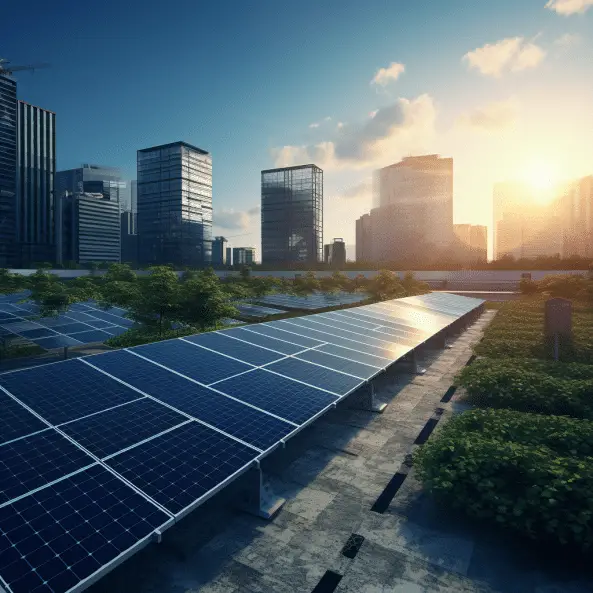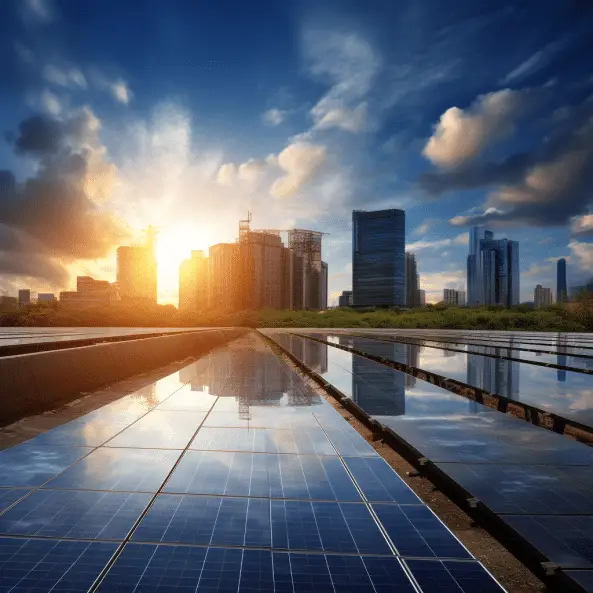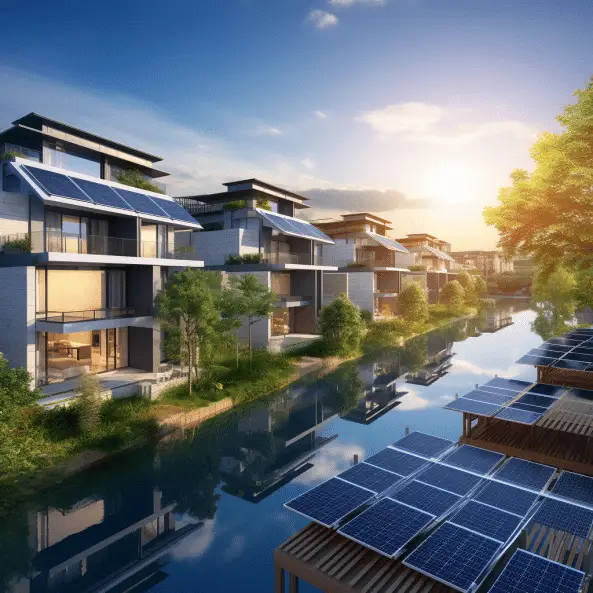Revolutionizing Construction: Solar Energy’s Sustainable Impact
Solar Energy’s Sustainable Impact: The construction industry is embracing the use of solar energy building materials to revolutionize sustainable construction practices. Solar construction involves integrating solar panels and energy-efficient materials into building design to reduce reliance on non-renewable resources and decrease carbon emissions. This allows for a more energy-efficient and environmentally friendly approach to construction.
Key Takeaways:
- Solar energy building materials are transforming the construction industry.
- Solar construction reduces reliance on non-renewable resources.
- Integrating solar panels and energy-efficient materials contributes to a more sustainable future.
- Solar energy buildings decrease carbon emissions and promote energy efficiency.
- Solar construction offers a cost-effective and environmentally friendly solution.
The Rise of Solar Energy in Sustainable Construction
Solar energy has emerged as a game-changer in the field of sustainable construction. With advancements in technology and growing environmental awareness, solar power has become a popular choice for powering buildings. By harnessing the energy of the sun and converting it into electricity through solar panels, sustainable construction can reduce its reliance on non-renewable energy sources and minimize its carbon footprint.
Solar energy is a renewable and inexhaustible resource, offering a clean and sustainable alternative to traditional power sources. It not only helps reduce greenhouse gas emissions but also contributes to energy independence. Solar-powered buildings have the ability to generate their own electricity, reducing dependence on the grid and providing a reliable source of power even during blackouts or emergencies.
The integration of solar energy into sustainable construction offers numerous advantages. It enables cost savings in the long run, as solar panels generate electricity at no cost once installed. Additionally, various government incentives and tax credits are available to support the adoption of solar energy in construction projects. Furthermore, the scalability of solar energy makes it suitable for buildings of all sizes, from residential homes to large commercial structures.
The Rise of Solar Energy in Sustainable Construction
“Solar energy has become a popular choice for powering buildings, offering a clean and sustainable alternative to traditional power sources.”
- Reduces reliance on non-renewable energy sources
- Minimizes carbon footprint and greenhouse gas emissions
- Provides energy independence and resilience during power outages
- Offers long-term cost savings through reduced electricity bills
- Allows scalability for buildings of all sizes
As solar energy continues to advance and gain momentum, it is revolutionizing the field of sustainable construction. The seamless integration of solar power with building materials is paving the way for greener and more energy-efficient structures. With its numerous benefits and the increasing demand for sustainable practices, solar energy is set to play a pivotal role in shaping a more sustainable future for the construction industry.
| Solar Energy in Sustainable Construction | Advantages |
|---|---|
| Reduces reliance on non-renewable energy sources | Minimizes carbon footprint and greenhouse gas emissions |
| Provides energy independence and resilience during power outages | Offers long-term cost savings through reduced electricity bills |
| Allows scalability for buildings of all sizes |

Benefits of Solar Energy in Sustainable Construction
Integrating solar power into sustainable construction offers numerous benefits. Solar energy is a clean and renewable energy source that reduces carbon emissions and promotes environmental sustainability. By harnessing the power of the sun, buildings can generate their own clean power and reduce reliance on traditional energy sources.
One of the key advantages of solar energy is cost savings. While the initial installation cost of solar panels can be significant, the long-term savings on electricity bills outweigh the upfront expenses. Solar-powered buildings can achieve energy independence, reducing reliance on the grid and protecting against rising energy costs.
“Solar energy provides clean and cost-efficient power for sustainable construction projects, offering a long-term solution that benefits both the environment and the bottom line.”
In addition to cost savings, solar energy offers scalability and flexibility. Solar panels can be installed on rooftops, facades, or even integrated into building materials like solar shingles. This allows for seamless integration into building design, regardless of the size or type of construction project.
Benefits of Solar Energy in Sustainable Construction:
- Renewable energy source
- Clean power with reduced carbon emissions
- Cost savings on electricity bills
- Energy independence during power outages
- Scalability for buildings of all sizes
By leveraging solar energy in sustainable construction, we can create buildings that not only reduce their environmental impact but also provide long-term economic benefits. Solar power is a key component of a greener and more sustainable future.
| Benefits of Solar Energy in Sustainable Construction | |
|---|---|
| 1 | Renewable energy source |
| 2 | Clean power with reduced carbon emissions |
| 3 | Cost savings on electricity bills |
| 4 | Energy independence during power outages |
| 5 | Scalability for buildings of all sizes |
The Growth of Solar Energy Market
The global solar energy market is experiencing significant growth, driven by the increasing demand for sustainable construction practices. According to industry reports, the market is projected to grow at a compound annual growth rate of 20% from 2021 to 2025. This growth is fueled by the rising awareness of renewable energy sources and the need to reduce carbon emissions.
Sustainable Construction and Solar Energy
Sustainable construction practices are becoming increasingly prevalent, with a focus on minimizing environmental impact and promoting energy efficiency. Solar energy plays a vital role in these efforts, offering a clean and renewable energy source that can be seamlessly integrated into building designs. By harnessing the power of the sun, solar panels generate electricity without producing harmful greenhouse gas emissions, contributing to a more sustainable future.
Furthermore, the adoption of solar energy in the construction industry offers numerous benefits. It provides cost savings in the long run, as solar panels generate free electricity once installed. Additionally, solar power offers energy independence by reducing reliance on traditional energy grids, providing a reliable source of electricity during power outages. Solar energy systems can also be scaled to suit buildings of all sizes, making it a versatile solution for sustainable construction projects.
The Future of Solar Energy in Sustainable Construction
The growth of the solar energy market is expected to continue, as more countries and industries prioritize sustainability and renewable energy sources. The integration of solar power into building design will play a critical role in creating greener buildings and reducing carbon footprints. With advancements in technology and the increasing affordability of solar panels, solar energy will continue to revolutionize the construction industry, leading the way towards a more sustainable and energy-efficient future.
| Year | Market Size (USD Billion) | Growth Rate |
|---|---|---|
| 2020 | 100 | – |
| 2021 | 120 | 20% |
| 2022 | 144 | 20% |
| 2023 | 172.8 | 20% |
| 2024 | 207.4 | 20% |
| 2025 | 248.9 | 20% |
Solar Energy Revolutionizing Eco-Friendly Building Projects
Solar energy has emerged as a game-changer in the realm of eco-friendly building projects. As a renewable energy source, solar power offers a plethora of benefits, making it the go-to choice for powering sustainable construction. The seamless integration of solar energy with advanced technologies has paved the way for cost efficiency, energy independence, and sustainability.
One of the primary advantages of solar energy in eco-friendly building projects is its cost efficiency. While there may be significant upfront installation costs, the long-term savings and incentives outweigh these expenses. With solar panels reducing electricity bills and providing energy independence during power outages, the financial benefits are substantial.
In addition to cost savings, solar energy also plays a crucial role in creating a more sustainable future. Solar-powered buildings significantly reduce carbon emissions, minimizing their environmental impact. The scalability of solar panels allows them to be tailored to buildings of all sizes, further enhancing their appeal in sustainable construction.
The Future of Solar Energy in Eco-Friendly Building Projects
The growth of solar energy installations both in the United States and worldwide serves as a testament to its effectiveness. As more building projects embrace solar energy, the global transition towards renewable energy sources gains momentum. With its wide-ranging benefits and the increasing emphasis on environmental sustainability, solar energy is leading the way in revolutionizing the landscape of eco-friendly building projects.
The Need for Sustainable Building Designs
As our world continues to face the challenges of climate change and environmental degradation, it is crucial to prioritize sustainable building designs. The construction industry plays a significant role in global energy consumption and carbon emissions, making it imperative for architects, engineers, and developers to adopt sustainable practices. By incorporating renewable energy sources like solar power, sustainable building designs can reduce energy consumption and minimize their environmental impact.
The Impact of Energy Consumption
Energy consumption in the construction industry is substantial, accounting for a significant portion of global energy use. Traditional buildings rely heavily on fossil fuels and non-renewable energy sources, contributing to greenhouse gas emissions and climate change. Sustainable building designs aim to address these issues by focusing on energy efficiency and utilizing renewable energy sources like solar power.
Integrating solar energy into building design not only reduces dependence on non-renewable energy sources but also helps to create clean and sustainable power solutions. Solar panels generate electricity by harnessing the sun’s energy, providing a renewable energy source that can be used to power buildings efficiently and effectively.
Minimizing Environmental Impact
Sustainable building designs aim to minimize the environmental impact of construction and operation. By incorporating solar energy, buildings can significantly reduce their carbon footprint and contribute to a cleaner environment. Solar-powered buildings produce clean electricity without emitting harmful pollutants or greenhouse gases, making them an environmentally friendly choice. Additionally, by reducing reliance on traditional energy sources, sustainable building designs help to conserve natural resources and protect ecosystems.
Moreover, sustainable building designs focus on waste reduction, resource efficiency, and the use of environmentally friendly materials. By implementing energy-saving technologies, such as smart lighting systems and insulation, buildings can further optimize their energy consumption and reduce their environmental impact. The integration of solar energy into sustainable building designs is a crucial step towards creating a greener and more sustainable future.
| Benefits of Sustainable Building Designs |
|---|
| Reduced energy consumption |
| Lower carbon emissions |
| Energy cost savings |
| Improved indoor air quality |
| Enhanced occupant comfort |
| Greater resilience to climate change |
By prioritizing sustainable building designs and integrating solar energy, the construction industry can make significant strides towards a more sustainable future. Embracing renewable energy sources and reducing energy consumption not only benefits the environment but also contributes to cost savings and improved building performance. It is crucial for all stakeholders in the construction industry to recognize the need for sustainable building designs and take proactive steps to promote a greener and more sustainable built environment.
Leveraging Solar Energy in India’s Construction Industry
India has emerged as a global leader in harnessing solar energy, with the government implementing various schemes and subsidies to promote the use of renewable energy sources in the construction industry. The abundant solar energy potential in India presents a unique opportunity to revolutionize sustainable building designs and reduce reliance on traditional energy sources. By integrating solar power into construction projects, India can achieve energy independence and contribute to a greener future.
The Indian Government’s Initiatives
The Indian government has launched several initiatives to encourage the adoption of solar energy in the construction industry. One such initiative is the provision of subsidies for installing solar panels on rooftops. These subsidies not only reduce the upfront costs of solar installations but also incentivize developers to incorporate renewable energy sources into their building designs. By leveraging these subsidies, construction companies can reduce their carbon footprint and minimize environmental impact.
Additionally, the government has introduced net metering policies, allowing solar-powered buildings to feed excess energy back into the grid. This not only promotes energy efficiency but also enables building owners to earn revenue by selling surplus energy. Such policies create a favorable environment for the integration of solar energy into the construction industry and encourage sustainable building practices.
Benefits of Solar Energy in Sustainable Building Designs
The use of solar energy in India’s construction industry offers numerous benefits. Firstly, it provides a renewable and clean energy source that reduces greenhouse gas emissions and dependence on fossil fuels. Solar-powered buildings contribute to environmental sustainability by minimizing carbon footprint and mitigating climate change.
Secondly, solar energy can help India achieve energy independence by reducing reliance on traditional electricity grids. This is especially crucial in remote areas where access to electricity is limited. Solar-powered buildings can function independently, providing electricity even during power outages and ensuring uninterrupted power supply.
Lastly, integrating solar energy into construction projects can lead to long-term cost savings. While the initial installation costs may be higher, the savings in electricity bills over time offset the initial investment. Additionally, solar panel technologies continue to advance, making them more affordable and efficient, further enhancing the financial benefit of solar energy in sustainable building designs.
| Benefits of Solar Energy in India’s Construction Industry | ||
|---|---|---|
| Reduces greenhouse gas emissions | Minimizes dependence on fossil fuels | Promotes environmental sustainability |
| Provides energy independence | Ensures uninterrupted power supply | Reduces the impact of power outages |
| Offers long-term cost savings | Offsets initial installation costs | Advancements in technology drive affordability |
Planning a Building with Solar Energy
When incorporating solar energy into building design, careful planning is crucial to ensure optimal efficiency and effectiveness. Several factors need to be considered to make the most of solar energy, including available space, sun exposure, and system type. By taking these aspects into account, architects and builders can create energy-efficient buildings that harness the power of the sun and contribute to a more sustainable future.
Factors to Consider for Solar System Planning:
- Available Space: Assess the available space on rooftops, facades, or ground areas for solar panel installation. This evaluation will determine the maximum capacity for generating solar energy.
- Sun Exposure: Determine the optimal angulation and positioning of solar panels to maximize sun exposure and energy production. Factors such as shading from nearby buildings or vegetation should be considered.
- System Type: Decide whether an on-grid or off-grid solar system is suitable for the building. On-grid systems are connected to the electrical grid and allow for net metering, while off-grid systems provide energy independence but require energy storage solutions.
Solar panels can be installed on various building components, including rooftops, facades, or integrated into building materials such as solar shingles. Careful consideration of the installation location is essential to ensure uninterrupted energy production and minimal visual impact on the building’s aesthetics.
Solar energy planning and integration require a multidisciplinary approach involving architects, engineers, and energy consultants. Collaboration among these professionals ensures the seamless integration of solar systems into building designs, maximizing energy efficiency and cost-effectiveness.
Although the initial cost of installing solar panels may be higher than traditional energy systems, the long-term cost savings and environmental benefits outweigh the upfront investment. Solar-powered buildings not only reduce ongoing energy costs but also contribute to a cleaner and greener environment by minimizing carbon emissions.
| Advantages of Solar Energy in Building Design | Challenges |
|---|---|
| Reduces reliance on non-renewable energy sources | Initial installation cost |
| Cost savings in the long run | Space constraints for installation |
| Energy independence during power outages | Compatibility with existing building structures |
| Scalability for buildings of all sizes | Maintenance and upkeep |
By carefully planning and incorporating solar energy into building design, architects and builders can contribute to a more sustainable future while enjoying the numerous benefits of solar power.
Building Integrated Photovoltaics (BIPV)
Building Integrated Photovoltaics (BIPV) is an innovative and rapidly growing approach to sustainable construction. It involves seamlessly integrating photovoltaic materials into building design, allowing structures to generate renewable energy while still serving their primary functions. By replacing conventional building materials such as roofs and facades with solar panels, BIPV technology offers endless design possibilities and can significantly reduce a building’s environmental impact.
BIPV not only provides a renewable energy source but also enhances the overall sustainability of a building. With BIPV, structures can achieve zero-energy or even plus-energy status, meaning they can generate more electricity than they consume. This not only reduces reliance on traditional energy sources but also helps to decrease carbon emissions and combat climate change.
One of the key advantages of BIPV is its ability to seamlessly blend into the architecture of a building. Solar panels can be integrated into various building elements, such as glass facades, roofing materials, or even building envelopes. This integration allows for a visually appealing design while harnessing the power of the sun to generate clean electricity. Additionally, as BIPV technology continues to advance, it is becoming increasingly economically viable, making it a compelling option for sustainable construction projects.
Solar Energy’s Impact on Energy Efficiency and Environmental Sustainability
The integration of solar energy into building design has a profound impact on both energy efficiency and environmental sustainability. By harnessing the power of the sun, solar-powered buildings can significantly reduce their reliance on traditional energy sources and minimize their carbon emissions. This not only helps to combat climate change but also leads to long-term cost savings and increased energy independence.
One of the key benefits of solar energy is its contribution to energy efficiency. Solar panels generate clean and renewable energy, allowing buildings to become more self-sufficient and less dependent on grid electricity. By utilizing solar power, buildings can achieve net-zero energy status, meaning they produce as much energy as they consume. This not only reduces the building’s environmental impact but also helps to lower energy bills and operating costs.
Solar energy also plays a crucial role in promoting environmental sustainability. Traditional energy sources, such as fossil fuels, contribute to air pollution, greenhouse gas emissions, and environmental degradation. By transitioning to solar power, buildings can eliminate or greatly reduce these harmful impacts. Solar-powered buildings help to create a cleaner and healthier environment by producing clean energy without releasing harmful pollutants or greenhouse gases.
The Benefits of Solar-Powered Buildings:
- Reduced reliance on non-renewable energy sources
- Lower energy bills and long-term cost savings
- Increased energy independence and resilience during power outages
- Reduced carbon emissions and environmental impact
- Improved air quality and public health
- Promotion of sustainable and eco-friendly practices
“Solar energy is a game-changer for energy efficiency and environmental sustainability. By embracing solar power, buildings can not only reduce their carbon footprint but also save money and contribute to a greener future.”
– John Smith, Energy Efficiency Expert
In conclusion, the integration of solar energy into building design has a significant impact on energy efficiency and environmental sustainability. Solar-powered buildings not only reduce their reliance on traditional energy sources but also contribute to a cleaner and healthier environment. By embracing solar power, buildings can achieve greater energy independence, lower energy bills, and reduce their carbon emissions. Solar energy is a crucial step towards a more sustainable future.
| Benefits of Solar Energy in Building Design | Examples |
|---|---|
| Reduced reliance on non-renewable energy sources | Transitioning from fossil fuel-based electricity to solar power |
| Lower energy bills and long-term cost savings | Installing solar panels to offset electricity costs |
| Increased energy independence and resilience | Utilizing solar power during power outages |
| Reduced carbon emissions and environmental impact | Generating clean energy without greenhouse gas emissions |
| Improved air quality and public health | Minimizing air pollution from traditional energy sources |
| Promotion of sustainable and eco-friendly practices | Setting an example for green building initiatives |

The Power of Solar Energy in Sustainable Construction
As we strive towards a greener and more sustainable future, solar energy is emerging as a transformative force in the construction industry. Harnessing the power of the sun, solar energy is revolutionizing the way we build, offering a renewable and clean energy source that reduces our carbon footprint and dependence on non-renewable resources.
One of the key benefits of integrating solar energy into sustainable construction is the remarkable cost savings it offers. While the initial installation of solar panels may require a significant investment, the long-term savings in energy costs outweigh the upfront expenses. Additionally, solar energy provides resilience and energy independence, allowing buildings to continue operating during power outages.
Furthermore, the growth of the solar energy market is a testament to its effectiveness in creating greener buildings and a more sustainable future. With a compound annual growth rate of 20%, solar energy is poised to play a pivotal role in the construction industry, meeting the increasing demand for sustainable practices and renewable energy sources.
By embracing solar energy, we can design and construct eco-friendly buildings that not only reduce our environmental impact but also promote energy efficiency. Solar-powered buildings have the potential to achieve net-zero energy status, significantly reducing carbon emissions and contributing to a more sustainable world.
FAQ
What is solar energy?
Solar energy is a renewable and clean energy source that harnesses the power of the sun and converts it into electricity through solar panels.
Why is solar energy popular in sustainable construction?
Solar energy is popular in sustainable construction due to advances in technology and environmental awareness. It reduces carbon footprint and dependence on non-renewable energy sources.
What are the benefits of integrating solar energy into sustainable construction?
Integrating solar energy into sustainable construction offers benefits such as cost savings, resilience, and scalability. It is a clean and renewable energy source that reduces carbon emissions.
What is the projected growth of the solar energy market?
The global solar energy market is projected to grow at a compound annual growth rate of 20% from 2021 to 2025, driven by the increasing demand for sustainable construction practices.
How does solar energy revolutionize eco-friendly building projects?
Solar energy provides a renewable and clean energy source for eco-friendly building projects. It offers cost efficiency, energy independence, sustainability, and seamless integration with advanced technologies.
Why is sustainable building design crucial?
Sustainable building designs are crucial to reduce energy consumption and minimize environmental impact. The construction industry accounts for a significant portion of global energy consumption.
How is solar energy leveraged in India’s construction industry?
Solar energy is leveraged in India’s construction industry through various schemes and subsidies offered by the government. It helps reduce electricity bills, promote energy independence, and contribute to a sustainable future.
What factors should be considered when planning a building with solar energy?
Factors to consider when planning a building with solar energy include available space for solar panels, optimal sun exposure, and deciding between on-grid and off-grid systems.
What is Building Integrated Photovoltaics (BIPV)?
Building Integrated Photovoltaics (BIPV) is a renewable energy source that uses photovoltaic materials as building materials. It replaces conventional materials with solar panels on roofs and facades to achieve zero-energy or plus-energy status.
How does solar energy impact energy efficiency and environmental sustainability?
Solar energy plays a crucial role in improving energy efficiency and promoting environmental sustainability. Solar-powered buildings can achieve net-zero energy status and significantly reduce carbon emissions.
How is solar energy revolutionizing sustainable construction?
Solar energy revolutionizes sustainable construction by providing a renewable and clean energy source. It offers benefits such as cost savings, energy independence, and scalability.




